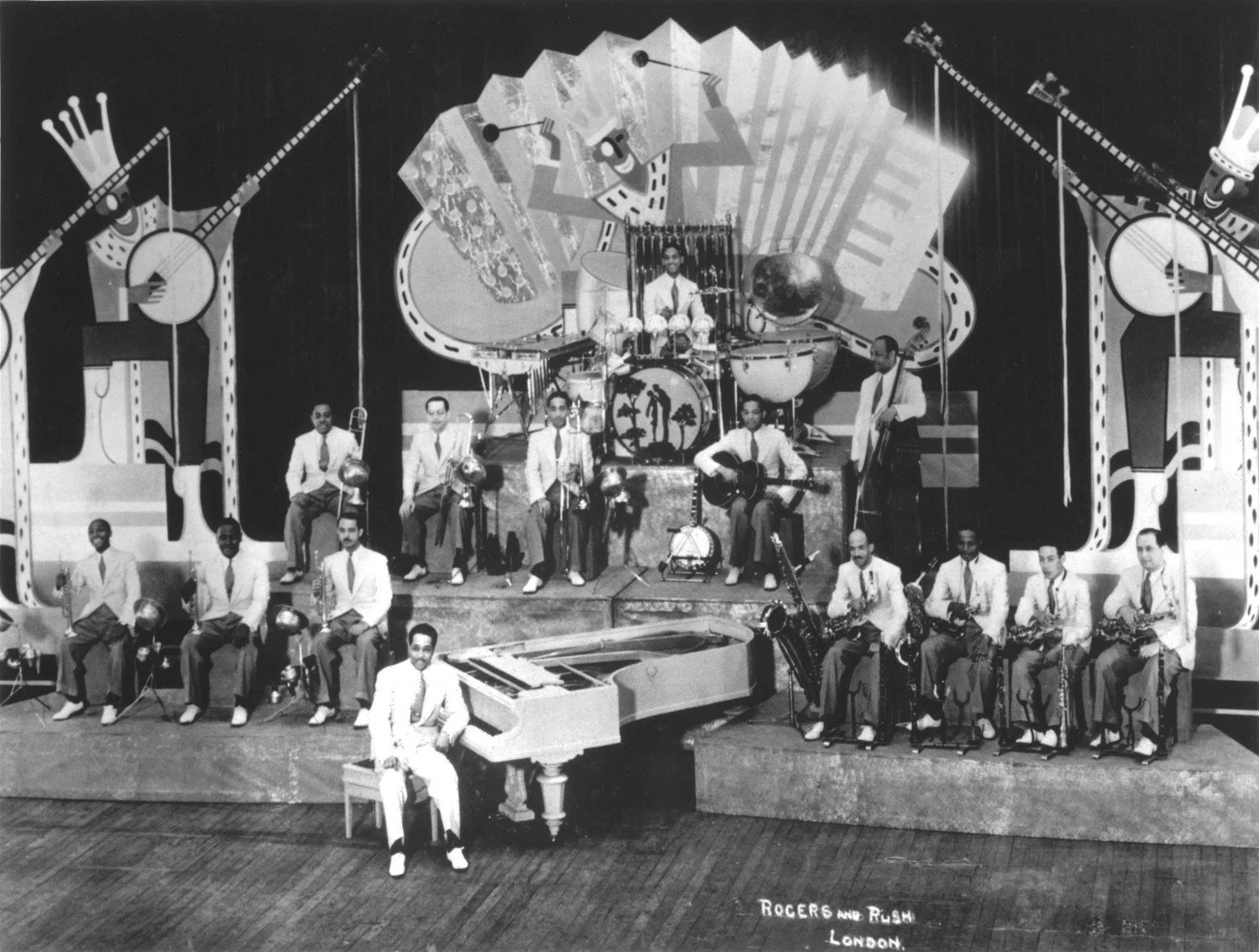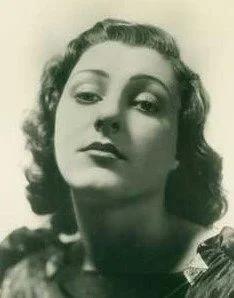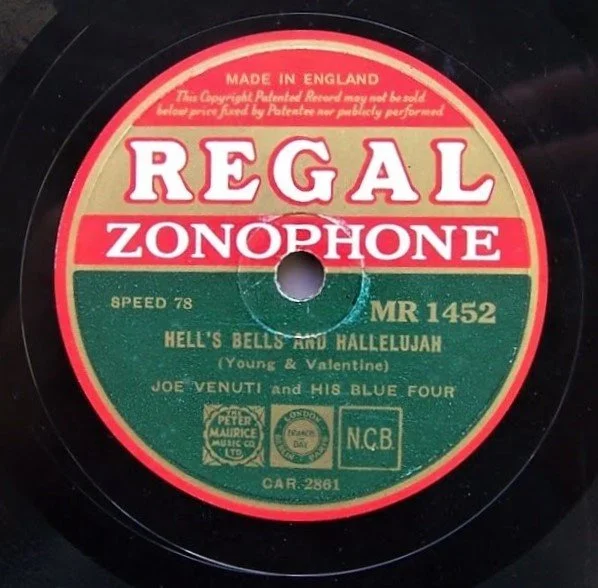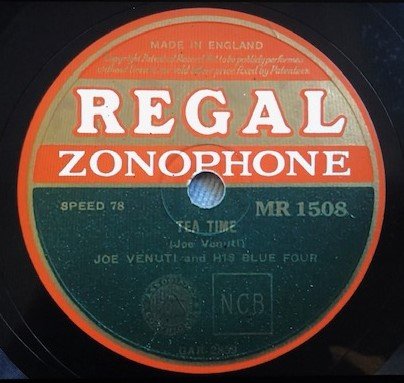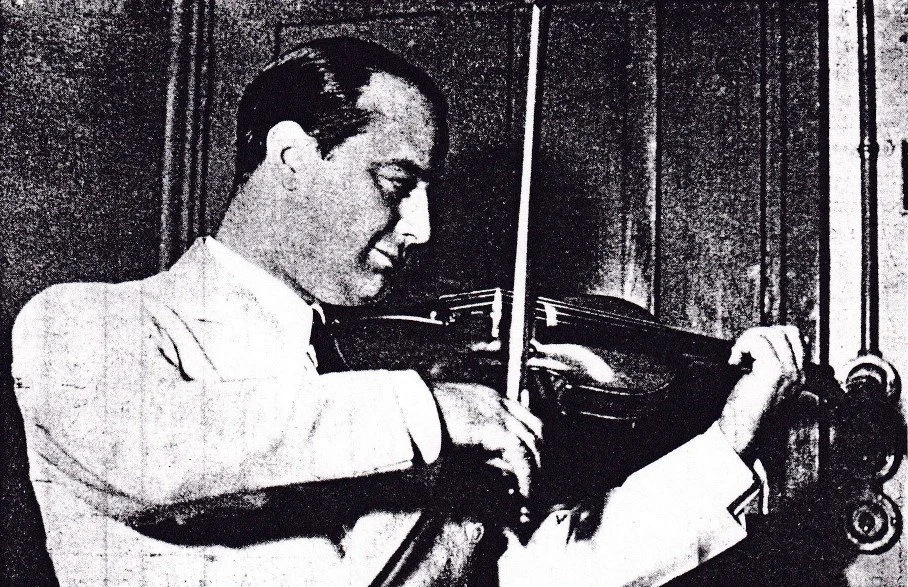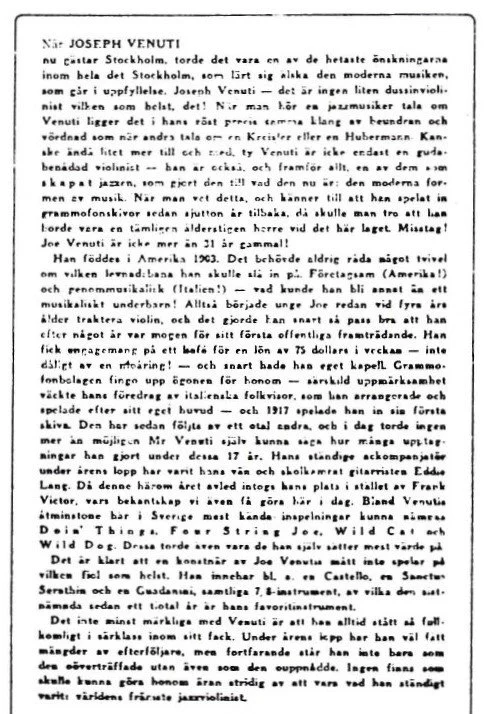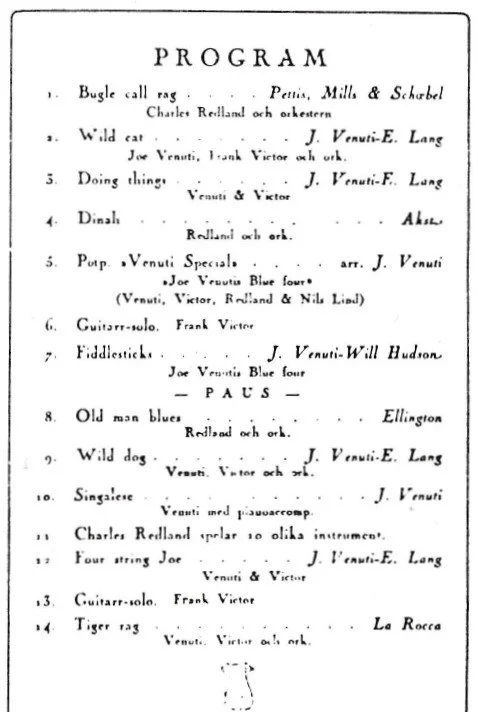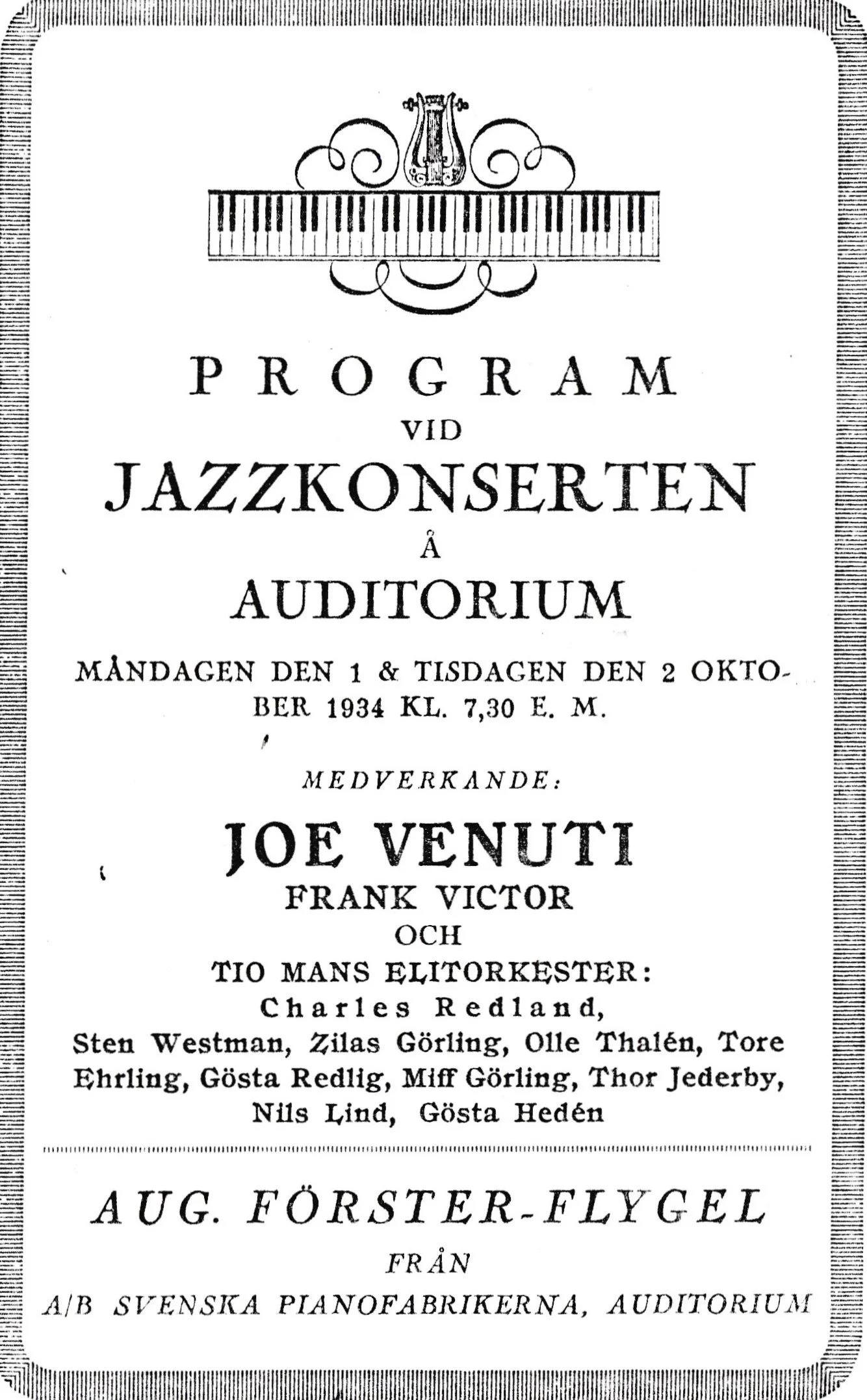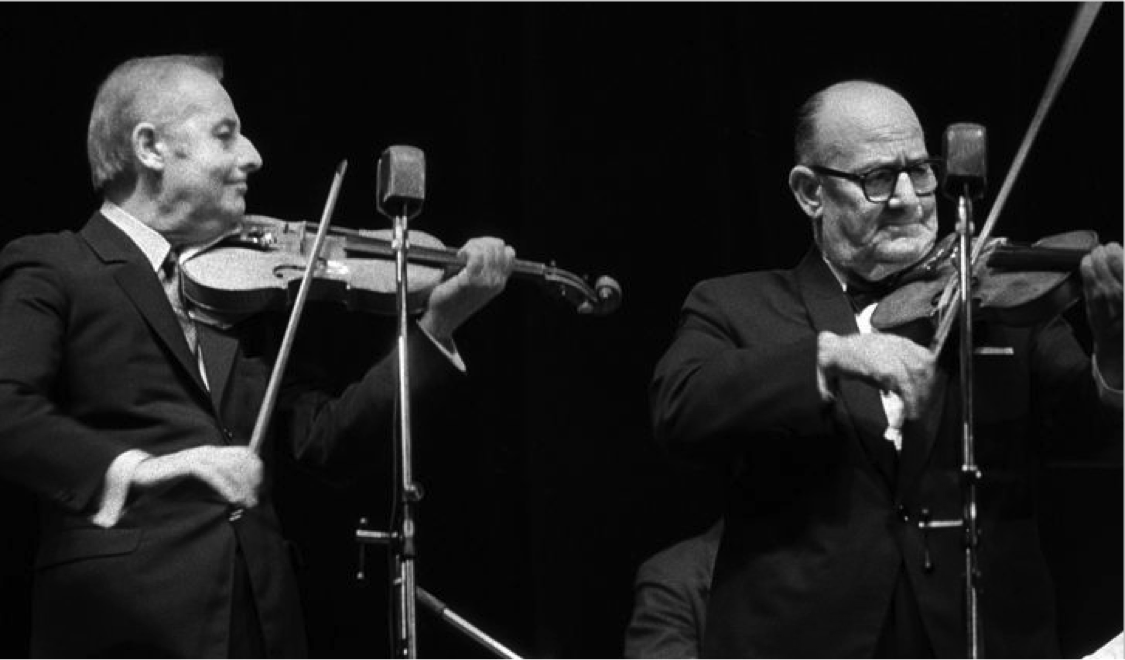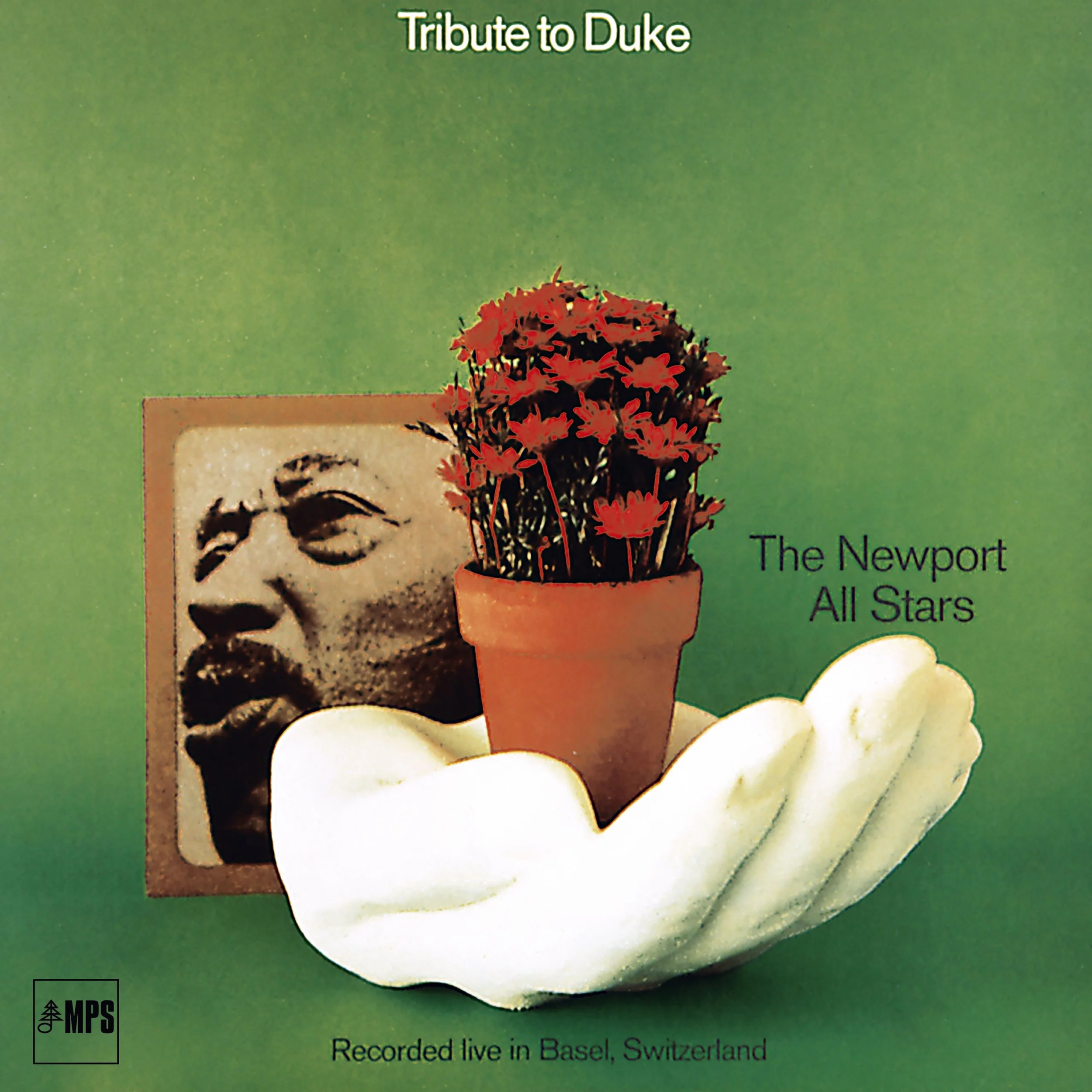Joe Venuti
Europe 1934 & 1969
The path Joe Venuti took, which brought him to Europe, was well paved by 1934. American bands (some possessing jazz elements, others with jazz players, and still others that were jazz bands) began crossing the Atlantic after the First World War (November 1918). The Original Dixieland Jazz Band and Will Marion Cook’s Syncopated Orchestra (with Sidney Bechet) journeyed in 1919. The nineteen-twenties and early ’30s saw Paul Whiteman, Sam Wooding, the Mound City Blue Blowers, Adrian Rollini, and Jimmy Dorsey, among others, make the crossing. Louis Armstrong’s 1932-34 tours, followed by Duke Ellington a year later, garnered extensive coverage exposing the genre across the continent.
NOTE: see SOURCES for an expanded timeline of American dance and jazz bands in Europe post-World War I.
Louis Armstrong, 1932.
Duke Ellington Orchestra, The Palladium, London, England, June 1933.
Louis Armstrong's arrival set the stage (and the standard) for European jazz sojourns. Initially booked by London impresario and producer George Black in 1932, Armstrong performed a fortnight (two weeks) of concerts at London's famed West End theater, the Palladium, and more dates around England. In 1933 and 1934, he was on stage in Denmark, Sweden, Norway, Holland, Belgium, France, and Switzerland. His presence on the continent was instrumental in growing an audience for jazz in these lands.
In the second half of the nineteen twenties, European musicians working ocean liners to and from America brought home records, sheet music, and first-hand accounts of New York's busy music scene. American jazz record issues throughout Europe, English radio broadcasts, and visiting American jazz artists led to the growth of jazz (hot) clubs and music publications, feeding a young market enticed by these new popular sounds and rhythms. This motivated European promoters and bookers to add American jazz to their variety shows.
“Danish musicians and composers who specially wanted to learn something found their best opportunity on the records. First came the platters of Paul Whiteman, Waring’s Pennsylvanians, Paul Specht, later Red Nichols, the brothers Dorsey, Trumbauer, Lang, Arthur Schutt, Miff Mole, Venuti, and more recently Casa Loma, Armstrong, Cab Calloway, Duke Ellington, and Boswell Sisters, mentioning the more popular ones.”
SOURCE: Dance Doings In Denmark by Otto Lington, at the Ritz, Copenhagen, The Metronome, March 1933.
A sample of American recordings issued on British labels
LOUIS ARMSTRONG & HIS HOT SEVEN-Willie The Weeper
SAM LANIN’S DANCE ORCHESTRA-Exactly Like You
JOE VENUTI AND HIS ORCHESTRA-Build A Little Home
JOE VENUTI and HIS ORCHESTRA-Hiawatha’s Lullaby
CAB CALLOWAY AND HIS ORCHESTRA-St. Louis Blues
FRANKIE TRUMBAUER with Bix Beiderbecke and Ed. Lang-For No Reason At All In C
EDDIE LANG - JOE VENUTI WITH THEIR ORCHESTRA-After You’ve Gone
THE CHARLESTON CHASERS-Under the direction of RED NICHOLS-Delirium
BIX BEIDERBECKE & HIS ORCHESTRA-I’ll Be A Friend “With Pleasure”
EDDIE LANG - JOE VENUTI AND THEIR ALL STAR ORCHESTRA-Farewell Blues
DUKE ELLINGTON-Black Beauty
JOE VENUTI-Violin, ED LANG-Guitar, ARTHUR SCHUTT-at the Piano-Goin’ Places
JOE VENUTI
1934
ENGLAND
As early as 1931, Joe Venuti and Eddie Lang may have been considering the prospect of touring Europe. It would be safe to assume that two of their closest colleagues, Adrian Rollini & Jimmy Dorsey, talked up the enthusiastic reception they received from overseas fans, music press, and record companies. The Venuti/Lang recordings, a particular favorite on the other side of the Atlantic, were the duo's calling cards, but fate had something else in store for them.
Note: Eddie Lang passed away in March of 1933.
c. February-March 1933: SALLY VENUTI.
“Joe is 29 years old, and his pet ambition is to tour the world with his own band. He would be well received no doubt, especially in Europe where his records have caught the popular fancy.”
SOURCE: THE METRONOME, April 1933.
August 3 (Fri): “On August 3, Joe called Nonno in Italy and told him that he had heard from Jack Mills of Mills Music, that his records were doing very well in Europe, and that he had received an offer to tour the continent.”
SOURCE: THE BLUE VIOLIN, by James Baxter, inspired by Robert White.
NOTE: see below re. THE BLUE VIOLIN.
Through the combined efforts of the (Irving) Mills Artists' Bureau in America and London, impresario and producer George Black, Joe Venuti, and Frank Victor, along with the Radio Rogues (aka Three Radio Rogues), were booked for a radio-themed performance at London's Palladium. This booking was Venuti's first overseas visit; he would return thirty-five years later in the final months of 1969 with George Wein's Newport All-Stars.
c. August 18 (Sat): Joe Venuti, Sarah (Sally) Venuti, Frank Viggiano (Frank Victor) depart NYC aboard the RMS Berengaria.
SOURCE: Melody Maker, August 25, 1934.
“Joe left for Europe on August 29, 1934, leaving his band at the (Million Dollar) Pier (in Atlantic City) to complete the engagement. Frank Victor, Joe’s accompanist, went with him to Europe. They sailed on the Berengeria (sic), crossed in six days, and landed at La Havre. On the boat with Joe were the Radio Rogues, Dave Apollon, and Helen Williams.”
SOURCE: THE BLUE VIOLIN, by James Baxter, inspired by Robert White.
The date noted in THE BLUE VIOLIN as August 29 is incorrect. The August 25 edition of Melody Maker offered a front-page account of Joe Venuti’s arrival in England on August 24.
THE BLUE VIOLIN is a bizarre tome that bounces back and forth between fiction (Venuti’s grandfather “Nonno from Milan” and a “Blue Violin”) and fact (dates and events, some spot-on, others a little loose, and what appears to be first-hand information). It’s a bit of a curious read; nonetheless, elements in the text hold up and advance the Venuti saga and are noted as such.
c. August 1934: Joe Venuti plays London Palladium for two weeks accompanied by guitarist Viggiani (sic) (Frank Victor) in a show titled Radio New York, with Teddy Joyce and his Band, Harry Richman, Evelyn Hayes, etc.
SOURCE: Dance Band Diaries Vol. 6, 1934-1935, Dance Band Diary, August 1934.
August 24 (Fri): Joe Venuti, Sarah (Sally) Venuti, Frank Viggiano (Frank Victor) arrive Southampton, England.
SOURCE: Melody Maker, August 25, 1934.
Frank Victor, Arthur Willcox, Joe Venuti, Sally Venuti, London, England, August 24, 1934.
JOE VENUTI IN LONDON
Sudden Arrival To Play In Palladium Bill Next Week
Matinee Prices Concessions To Our Readers
Extraordinary Band Complication
Teddy Joyce Announced To Appear
For ten years now - in fact, ever since Joe Venuti first became a recording idol for his bands as Red Nichols and His Five Pennies, Joe Venuti’s Blue Four, etc – British dance musicians have longed for the day when they might see and hear the master in person in this country.
With dramatic suddenness, their wish is to be long last granted by the London Palladium bookers, who, conceiving the idea of building up an “American Radio Show” as a variety entertainment, got into touch with Mills Artists’ Bureau America, through Harry Foster, the agent, and secured Venuti, who’s on the bureau’s books.
Joe arrives to-day (Friday, August 24th) on the “Berengaria” and will appear at the Palladium on Monday to commence a fortnight’s engagement.
He travels (with) his own guitar accompanist, Viggiani (sic), of whom little is known beyond the fact that his real name is Frank Victor, that he was once the guitarist in Paul Specht’s Orchestra, and that he conducts the Guitarist Advice Corner in the American “Metronome.” In that he has been chosen by Venuti, one may expect him to be a player of considerable consequence.
HINT OF LITIGATION
Nobody interested in dance music will miss seeing and hearing Venuti if it is at all possible. Not only violinists worship at his shrine, but all dance musicians, for he is a pioneer of hot rival Eric Siday, the British player.
Venuti’s style is of the undating quality, like all good style’s such as Louis Armstrong’s and Duke Ellington’s. Any of his ten-year-old records have still power to amaze the students of 1934 by the sheer brilliance of his technique and the inventiveness of his phrasing. Great concert virtuosi such as Heifetz and Kreisler have sought him out and commend his rhythm playing whole-heartedly.
Musicians’ Chance
It is, of course, only right on the occasion of his visit the Melody Maker should mark it fittingly. By the co-operation of the G.T.C. (?) it is made possible to do so in a highly practical manner, as the boxed particulars of a Matinee Price Concession to Melody Makers apply testify.
Venuti is likely to make the “musicians matinees” specially interesting for the boys, and thousands of readers will surely take advantage of the Palladium's generous gesture.
His act, which, on the occasions he has appeared on the boards in American theatre has been composed of hot playing and many amazing fiddleistic tricks, is to be an item in a quick-fire modern type of American presentation which should prove genuinely interesting and amusing to all music-hall patrons.
Options Question
The show is called “Radio New York.” In support are Teddy Joyce and his band - Teddy also acting as compere, Greta Keller, the Three Radio Rogues, Joe Griffen, the new Harry (Puttin’ On The Ritz) Richman -and Evelyn Hayes “hot” singer.
But for Melody Maker readers it is Venuti, Venuti all the time, and we feel we can promise him the reception of a lifetime.
SOURCE: Melody Maker, August 25, 1934 (transcribed).
REGAL TREAT FOR JOE AND “RED” FANS
Kraut Obliges With New Discs
There’s a treat in store for fans at a price they can well afford.
Joe Venuti and Nichols are among the masters to be issued soon in this country, thanks to Alex Kraut, the adventurous director of Regal.
The bright green and red label on Regal-Zonophone records has always been regarded by discerning gramophone fans as a sign of superlative value, but for the coming Winter Season Kraut is eclipsing all previous efforts in this direction.
In addition to the fine British bands that are regularly featured, no fewer than seven first-class American outfits will appear in the list, including such maestros as Red Nichols.
But, in view of his appearance in London next week, Joe Venuti’s first disc under this label must take pride of place in interest. This is scheduled for release on October 1, a date to which fans will doubtless look forward with eager anticipation, as it is not every day that one can buy a Venuti disc for the small sum of 1s. 6d.
Kraut has more fine dishes for the disc hunters shortly.
SOURCE: Melody Maker, August 25, 1934 (transcribed).
August 25 (Fri): RADIO NEW YORK
“Radio New York” is the title of a spectacular presentation at the Palladium next week, which will show famous American broadcasters in their natural setting.
In a background reminiscent of a New York radio studio will be seen Joe Venuti, the pioneer of “hot” violin playing, supported by a cast of broadcasting stars, including Teddy Joyce and his band, the Three Radio Rogues, and many other acts familiar to British listeners.
SOURCE: Extract from Morning Post LONDON, 25 AUG 1934, International Press-Cutting Bureau, 110, Fleet Street, London, E.C.4.
Joe Venuti, Frank Victor, 1934
Teddy Joyce and His Band
Greta Keller, 1934
The Radio Rogues, 1936
Harry Richman
Evelyn (Evie) Hayes
RADIO NEW YORK
THE PALLADIUM
AUGUST 27-SEPTEMBER 1
August 27 (Mon) : Joe Venuti, Frank Victor, Teddy Joyce and his band, the Three Radio Rogues, Greta Keller, Harry Richman, Evelyn Hayes, Joe Griffen VARIETY SHOW, The London Palladium, London, England (evening performance).
August 28 (Tue) : Joe Venuti, Frank Victor, Teddy Joyce and his band, the Three Radio Rogues, Greta Keller, Harry Richman, Evelyn Hayes, Joe Griffen VARIETY SHOW, The London Palladium, London, England (evening performance).
August 29 (Wed): Joe Venuti, Frank Victor, Teddy Joyce and his band, the Three Radio Rogues, Greta Keller, Harry Richman, Evelyn Hayes, Joe Griffen VARIETY SHOW, The London Palladium, London, England (matinee performance).
August 29 (Wed): Joe Venuti, Frank Victor, Teddy Joyce and his band, the Three Radio Rogues, Greta Keller, Harry Richman, Evelyn Hayes, Joe Griffen VARIETY SHOW, The London Palladium, London, England (evening performance).
August 30 (Thu): Joe Venuti, Frank Victor, Teddy Joyce and his band, the Three Radio Rogues, Greta Keller, Harry Richman, Evelyn Hayes, Joe Griffen VARIETY SHOW, The London Palladium, London, England (matinee performance).
August 30 (Thu): Joe Venuti, Frank Victor, Teddy Joyce and his band, the Three Radio Rogues, Greta Keller, Harry Richman, Evelyn Hayes, Joe Griffen VARIETY SHOW, The London Palladium, London, England (evening performance).
August 31 (Fri): Joe Venuti, Frank Victor, Teddy Joyce and his band, the Three Radio Rogues, Greta Keller, Harry Richman, Evelyn Hayes, Joe Griffen VARIETY SHOW, The London Palladium, London, England (evening performance).
September 1 (Sat): Joe Venuti, Frank Victor, Teddy Joyce and his band, the Three Radio Rogues, Greta Keller, Harry Richman, Evelyn Hayes, Joe Griffen VARIETY SHOW, The London Palladium, London, England (evening performance).
September 1 (Sat): p1, Melody Maker.
SOURCE: Melody Maker, August 25, 1934.
SOURCE: Louis, The Louis Armstrong Story 1900-1971, Max Jones, John Chilton, Little, Brown and Company, 1971.
RADIO NEW YORK
THE PALLADIUM
SEPTEMBER 3-SEPTEMBER 8
September 3 (Mon): Joe Venuti, Frank Victor, Teddy Joyce and his band, the Three Radio Rogues, Greta Keller, Harry Richman, Evelyn Hayes, Joe Griffen VARIETY SHOW, The London Palladium, London, England (evening performance).
September 4 (Tue): Joe Venuti, Frank Victor, Teddy Joyce and his band, the Three Radio Rogues, Greta Keller, Harry Richman, Evelyn Hayes, Joe Griffen VARIETY SHOW, The London Palladium, London, England (evening performance).
September 5 (Wed): Joe Venuti, Frank Victor, Teddy Joyce and his band, the Three Radio Rogues, Greta Keller, Harry Richman, Evelyn Hayes, Joe Griffen VARIETY SHOW, The London Palladium, London, England (matinee performance).
September 5 (Wed): Joe Venuti, Frank Victor, Teddy Joyce and his band, the Three Radio Rogues, Greta Keller, Harry Richman, Evelyn Hayes, Joe Griffen VARIETY SHOW, The London Palladium, London, England (evening performance).
September 6 (Thu): Joe Venuti, Frank Victor, Teddy Joyce and his band, the Three Radio Rogues, Greta Keller, Harry Richman, Evelyn Hayes, Joe Griffen VARIETY SHOW, The London Palladium, London, England (matinee performance).
September 6 (Thu): Joe Venuti, Frank Victor, Teddy Joyce and his band, the Three Radio Rogues, Greta Keller, Harry Richman, Evelyn Hayes, Joe Griffen VARIETY SHOW, The London Palladium, London, England (evening performance).
September 7 (Fri): Joe Venuti, Frank Victor, Teddy Joyce and his band, the Three Radio Rogues, Greta Keller, Harry Richman, Evelyn Hayes, Joe Griffen VARIETY SHOW, The London Palladium, London, England (evening performance).
September 8 (Sat): Joe Venuti, Frank Victor, Teddy Joyce and his band, the Three Radio Rogues, Greta Keller, Harry Richman, Evelyn Hayes, Joe Griffen VARIETY SHOW, The London Palladium, London, England (evening performance).
SOURCE: Melody Maker, August 25, 1934.
SOURCE: Louis, The Louis Armstrong Story 1900-1971, Max Jones, John Chilton, Little, Brown and Company, 1971.
September 8 (Sat): Joe Venuti Rehearses
SOURCE: Melody Maker, September 8, 1934, p1, 4, 9, 11.
c. September: Joe Venuti is rehearsing with a band led by pianist Billy Mason.
SOURCE: Dance Band Diaries Vol. 6, 1934-1935, Dance Band Diary/September 1934.
September 15 (Sat): Joe Venuti To Tour Continent
There has been much discussion as to Joe Venuti’s immediate future this side of the Atlantic.
During his second week at the Palladium, it was suggested that he head a road show, in conjunction with Joe Phillips, the American comedian, top-lining this week at the Argyle-street house. Joe was to take with him Billy Mason’s band, a troupe of girls, and several supporting acts.
Details are not yet fixed, however, and negotiations are still going on at the time of closure for press.
Plans are also afoot for an extended Continental tour of France, Belgium, Holland, etc.
If this latter materializes, he would, of course, take Frank Victor, the guitarist, with him, but it is unlikely he would tour a full band.
Further interesting news is that Alex Kraut, of Regal-Zono, ever on the alert for good stuff, has arranged that Joe shall record four of his own titles within the next few days.
Joe will have the assistance of Frank Victor and two other men, one of them almost certainly Arthur Young (whom Joe thinks is the best pianist he has heard this side of the water), and a bass player not yet decided upon.
The idea is to make the titles on the style of the celebrated Blue Four.
Frank Victor is also scheduled for a couple of solos, which is news of first-class importance to all guitarists.
SOURCE: Melody Maker, September 15, 1933, courtesy of Nick Dellow.
September 16 (Sun): Joe Venuti celebrates his thirty-first birthday (b. September 16, 1903).
September 20, 1934 (Thu): Joe Venuti, Frank Victor, Arthur Young, Don Barrigo, Doug Lees RECORDING SESSION, Regal-Zonophone, Regal Studios, London, England.
SATAN’S HOLIDAY (Venuti)
TEA TIME (Venuti)
ROMANTIC JOE (Venuti)
HELL’S BELLS AND HALLELUJAH (Young & Valentine)
SOURCE: Melody Maker, September 29, 1934
SOURCE: Bjorn Englund, Storyville, April-May 1975.
NOTE: In March of 35, Barrigo wrote a glowing article on visiting American artist Coleman Hawkins, calling him “undoubtedly the greatest of all the tenor players.”
SOURCE: Ballroom and Band, March 1935.
Melody Maker, September 29, 1934. (PLACEHOLDER IMAGE)
Venuti Records In England
Round the Studios ……. By “Gray”
I wonder how many of you thousands of admirers of Joe Venuti ever contemplated the possibility of his making records in a British studio, yet that seeming miracle became actuality just over a week ago through the enterprise of Alex Kraut.
It was a real hot time in the Regal-Zonophone studios when Joe, with Frank Victor, Arthur Young, Don Barrigo and Doug Lees got together and made three titles, which sounded as though they will stand comparison with anything this violin wizard has ever done.
The Numbers are Devil’s Holiday and Tea Time by Joe Venuti, and Hell’s Bell And Hallelujah by Arthur Young, who on this session proved that as a musician he can hold his own with anyone in the world.
Don, of course, shot some good stuff on his tenor, and Douggie Lees was simply grand on the bass and amply justified the compliment paid him, feeding Joe with just the stuff he wanted as though he had been playing with him all his life.
One of the best movements in the three sides comes when Joe, getting tired of the fiddle, joins Frank in a guitar duet, with the imperturbable Lees doing his stuff at the back.
For the fourth side, Joe went right away from his usual, but no one will quarrel with that, as he has recorded a beautiful violin solo called Romantic Joe, accompanied by Arthur Young, and it is safe to say that to those who only know him as a extractor of white heat from a fiddle this will come as a pleasing revelation.
SOURCE: Melody Maker, September 29, 1934 (transcribed).
NOTE: According to a report in the Melody Maker, 'Alex Kraut - the supreme novelty spotter of the recording business'.
Arthur Young, Joe Venuti, Doug Lees, Don Barrigo, Alex Kraut, Frank Victor, Regal Studios, London, England, September 20, 1934. (PLACEHOLDER IMAGE)
After Eddie Lang’s death, Joe never again teamed up with another guitarist or, for that matter, another musician. He did take “Frankie” (as Venuti called him) Victor to Europe on a brief English and Scandinavian tour in 1934. Victor was a good player in the Lang mold and provided the violinist with solid accompaniment (he ended the decade as a member of the Adrian Rollini Trio). Eventually, the guitar issue became such a sore point with Venuti that by the late thirties, he eliminated the instrument from his orchestra (“There just don’t seem to be any Langs around nowadays”). Joe’s favorite Lang protégé was Tony Romano (of Bob Hope fame), but the violinist never committed to much more than a few recording sessions and gigs.
Billed as “Radio New York,” the variety show package brought Joe to London’s Palladium for a series of performances evoking “American broadcasters in their natural setting.” After several weeks in London, Joe and Frank Victor entered the Regal studios with Brits Arthur Young, Don Barrigo, and Doug Lees. The four sides recorded by the quartet find Venuti in exceptional form. He’s particularly explosive on HELL’S BELLS AND HALLELUJAH (Barrigo’s best moment) and offers a chorus with double-stop riffs and ascending single-line phrases on DEVIL’S HOLIDAY that positively lifts the musicians out of their seats. Joe was in such a good mood that he even picked up Frank Victor’s spare Gibson L-5 and took a guitar solo on ROMANTIC JOE (listen for the “trill”). The English musicians are more than up to interpreting Venuti’s music. Joe was most impressed with Young’s piano playing, comparing his skills to “The Baron” (Arthur Schutt). Arthur Young was one of Stephane Grappelli’s favorite keyboard players, working with him often in London during the Second World War. Venuti uses Barrigo’s tenor sax sparingly to good effect. Bassist Lees drives the ensemble with a solid four-beat. These four tunes recorded qualify as one of Joe Venuti’s outstanding sessions and easily stand alongside the classic records he produced with Eddie Lang.
You’ll find below that the Rhythm Record Review by Eric Ballard disagrees. Still, even he had to admit that “they certainly recapture some of the old atmosphere (of the Venuti-Lang Blue Four) and with more opportunities to get together could develop into a classic outfit.”
SOURCE: The Classic Columbia and OKeh Joe Venuti and Eddie Lang Sessions, Notes by Mike Peters, Mosaic Records MD8-213, 2002.
SATAN’S HOLIDAY & HELL’S BELLS AND HALLELUJAH.
Here is a record that I can’t say very much about. What can one say about Venuti – when he plays in his grand old style as he does here? Nothing, he is just Venuti. This is the English Blue Four with Arthur Young and Don Barrigo. There is, in addition to Venuti’s playing, some piano playing that is worth hearing; a good string bass backing; and some extremely original tenor from Don. Frank Victor, of course, is there too.
For many reasons it would be unfair to compare this combination with old Blue Fours. For one thing the members have only played together for the shortest of periods. But they certainly recapture some of the old atmosphere and with more opportunities to get together could develop into a classic outfit.
SOURCE: E.A.C.B. (Eric A.C. Ballard): Ballroom and Band, Rhythm Record Review, December 1934 (transcribed).
TEA TIME & ROMANTIC JOE.
I am rather disappointed with “TEA TIME.” It is the English Blue Four, of course, and though there is nothing in it that one could call bad it fails to make any marked impression. Joe plays well, but I’ve heard him play better. His opening movement, however, is very pleasant. The same thing can be said about the eight bars solo that Don Barrigo takes. Frank Victor plays a single string solo with bass and guitar accompaniment, the latter being played presumably by Venuti, that suffers from inferior recording. The main fault, I think, is that the fire of the old Parlophone records is lacking. Good as Victor is one cannot help thinking of Ed Lang and wishing he was there, while some of that terrific bass from Rollini would make a world of difference.
“ROMANTIC JOE” is rather outside my sphere. It is obviously aimed at a commercial public with whom it should be popular. It has nothing to do with hot music, of course, but it is extremely well played and the absence of that banality that marks most commercial violin solos is a great point in its favour.
SOURCE: E.A.C.B. (Eric A.C. Ballard): Ballroom and Band, Rhythm Record Review, January 1935 (transcribed).
September 22 (Sat): Joe Venuti, Frank Victor, Melody Maker p1.
SOURCE: Melody Maker, September 22, 1934.
Joe Venuti c. 1934. (PLACEHOLDER IMAGE)
JOE VENUTI
1934
COPENHAGEN, DENMARK
There are two different reviews of the concerts given by Joe Venuti in Copenhagen: Joe Venuti in Scandinavia, in 1934, Bjorn Englund, Storyville, April-May 1975, and Joe Venutis Koncert by Svend Asmussen, h.o.t. tidsskrift for modern music, 7 Oktober November (1934) (translated & transcribed). Together, they bring the September 24 & 26 Venuti Copenhagen concerts back to life.
September 23 (Sun): Joe Venuti, Sarah (Sally) Venuti, Frank Viggiano (Frank Victor) depart London, England for Copenhagen, Denmark.
September 24, 9 am (Mon): Joe Venuti, Sarah (Sally) Venuti, and Frank Viggiano (Frank Victor) arrive in Copenhagen, Denmark, by train.
SOURCE: Joe Venuti in Scandinavia, in 1934, Bjorn Englund, Storyville, April-May 1975.
In 1934 Joe Venuti visited Europe for the first time and was not to return there until more than three decades later. The first trip has not been properly documented; some books such as Feather’s Encyclopedia, give the impression that he only toured England; other books talk vaguely of a ”European Tour” without specifying the countries. Even Chilton’s meticulously researched book makes the slip of referring to Venuti bringing “a small group” to Europe. John has since assured me that this was just a mistake and that in fact Venuti brought only guitarist Frank Victor with him.
The British tour is outside the scope of this article, and it is said to have been highly successful, and on 20 September 1934, Venuti and Victor teamed with a British studio group to record four sides for Regal Zonophone.
Four days after this session., on the 24th September, Venuti and Victor arrived in Copenhagen by train ay 9a.m. and were greeted by the press and fellow musicians. In one of the interviews Venuti disclosed that Doin’ Things was based on Debussy’s La Fille aux cheveux de lin (No. 8 in Book 1 of the Preludes) and that Wild Dog was a paraphrase of a Paganini composition. (Has this information ever been published elsewhere?).
September 24, 8pm (Mon): Joe Venuti, Frank Victor, Otto Lington Orchestra, CONCERT, Odd Fellow Palaet (Palace), Copenhagen, Denmark.
September 26, 8pm (Wed): Joe Venuti, Frank Victor, Otto Lington Orchestra CONCERT, Odd Fellow Palaet (Palace), Copenhagen, Denmark.
At 8 p.m. that evening and again at the same time on the 26th of September, Venuti and Victor gave a concert at Odd Fellow Palaet accompanied by the Otto Lington Orchestra. The programme ran as follows: Chinatown, Wild Cat, Doin’ Things, In A Mist (played by Richard Stangerup on the marimba), Fiddlesticks (violin and guitar only), Romantic Joe (actually Four String Joe), and Tiger Rag. As an encore they played Saa Ruller Vi Samme Vej!, a Danish tune by Kai Normann-Andersen from the ‘Apollo Revue’ of 1933. The concerts were quite successful, but not of course, quite as much as those of Louis Armstrong the previous year.
CHINATOWN
WILD CAT
DOIN’ THINGS
IN A MIST (played by Richard Stangerup on the marimba)
FIDDLESTICKS (violin and guitar only)
ROMANTIC JOE (Actually FOUR STRING JOE)
TIGER RAG
SAA RULLER VI SAMME VEJ! (encore)
SOURCE: Joe Venuti in Scandinavia, in 1934, Bjorn Englund, Storyville, April-May 1975 (transcribed).
About Svend Asmussen's September 29 & 30 Concert Review.
A Venuti protégé, avid Venuti/Lang record collector, music devotee (Jazz and Classical), and burgeoning Scandinavian jazz star, Svend Asmussen knows the Venuti & Lang songbook intimately. At this time in his musical development, Asmussen was emulating Joe Venuti's violin style and carefully studying the maestro's solos from the published Robbins Music folios. From Venuti's Blue Four recordings, then issued in Europe, he modeled his violin, guitar, bass saxophone, and piano ensemble.
Asmussen was the ideal candidate to review these shows. An astute observer, he gives us a front-row seat in Copenhagen's Odd Fellow Palaet (Palace) with a first-hand account of Venuti's September 29 & 30 performances, vividly covering the technical side of Venuti's violin style (his sound and bow technique), along with an honest analysis of the repertoire and performance. In addition to the concert selections scheduled for the show(s), Asmussen brings to light pieces not listed in the concert program, including the encores. This play-by-play performance critique is a unique entry in Joe Venuti's golden era.
NOTES
The translation from Danish to English appears odd at times and will be updated when revisions are available; that said, the overall impact of Asmussen’s review is clear and revealing.
Asmussen's reference to "Little Man" is probably "Little Girl."
Joe Venutis Koncert by Svend Asmussen, h.o.t. tidsskrift for modern music, 7 oktober November (1934). (PLACEHOLDER IMAGE)
Joe Venutis Koncert (review) by Svend Asmussen (translated & transcribed)
It was a pleasant surprise that the Copenhageners' preliminary interest in Venuti's exclusive, cultured style was so great that the large hall was practically full. But I also don't think that afterwards there was a single person who regretted the cost of the ticket and considered the evening wasted.
What therefore surprised me the most was that Venuti's playing was perfectly correct in every respect from a "classical” times better impression than what you get from the records. It was already noticeable with the first number, "Wild Cat." This little number from the album with Venuti and Lang is one of the best known in this country, among others, because it is Otto Lington's regular brilliant number. The fine clarinet accompaniment he has arranged for this, Venuti thinks is excellent and used it himself.
I still think that Venuti would have been wiser to take "The Cat" with Frank Victor alone, as on the record. Because no matter how softly and discreetly the clarinets blew, due to their jagged, firm wind tone, they seemed deafening compared to the airy, shrill violin tone. Many were initially a little disappointed. But it didn't last long. When you had learned a bit not to like the piercing, often quite sharp and basically unviolin-like sound from the records, you realized that it was much better in reality. What a tone! The gentlest heat violin tone from a precious old Cremonese. However, was docile like the gypsies in Budapest, but not vapid like theirs. It was not big, but wonderfully graceful and charming.
And then the bow technique!
It was very liberated and relaxed, as you only find it in a few great virtuosos. That side of Venuti's violin playing was actually so completely correct that it can be described as ideal. The third side, the left-hand technique, was certainly excellent, the purity impeccable; but here, however, there is undeniably a great leap to the fantastic, unfailing safe bed, which, for example, Milstein, who is just visiting the city, possesses. It thus happened repeatedly to Venuti that fairly light flageolettes failed completely. The many cadences, trills, lobs, things and things that he shook out of his sleeve in abundance, indeed sound very difficult and bribery. But quite apart from the fact that it is all very easy and natural, it is all like phrases that he has used countless times over the years.
It also turned out, as with Armstrong, that there was very little that could really be called nothing at all within the program itself. "Wild Cat" was thus carefully worked through and gens every time. Likewise, "Doin' Things" and "Wild Dog", which are two of Venuti's very best compositions; the forest with the adorable, little recurring motif from Debussy's "The maiden with the flaxen hair" as the basis.
"Wild Dog" contains two good ideas: the four-bar staccato rise and the middle section in broken chords over the strings, while the slow theme seemed a bit too haphazard and over-grounded. The small potpourri of well-known melodies began as "Pardon Me". The cadence was the same as on the record, the melody itself partly improvised in a lovely light and handy style with an excellent rhythmic swing. "Tea For Two" was played very beautifully and imaginatively varied, while "I Got Rhythm" in a devilish tempo gave Joe the opportunity to shine with his phenomenal bow. But he did not allow himself to improvise at that pace. "Little Man" and "Sweet Sue" were played in the old style as "Tea For Two" and "Pardon Me" respectively.
Together with the orchestra, "Fiddlestick" was given an excellent presentation, especially at the second concert, when V.s. tone flick the right soloistic touch with the help of the microphone. "Tiger Rag" was not particularly exciting. The whole long introduction with the many breaks was improvised, but all the figures were familiar, and one in particular was repeated endlessly. It seemed very funny after the first chorus in A major to go up a semitone with violin and guitar solo (it's much easier now to play in cross-tones on the ham, isn't it, Mr. Venuti?). "Romantic Joe" was a quite endearing little solo number that contained good ideas that were, however, not entirely original (e.g. points of similarity with Svendsen's violin romance).
Venuti is often referred to above all as a four-string specialist. I do not know whether he may have invented the style himself; in any case, he is the one who has cultivated it especially and with great success.
The tone is here again surprisingly beautiful and clear, the purity is actually impeccable. Few people know how difficult four-string techniques really are, especially in terms of purity and tone! After the small slow solo introduction, which had an almost organ-like character, fragments of various records came, e.g. “Tempo di Barrel” and “Four-String Joe”. What a swing both of you slowly and fast pace! The two places that seemed to require the most fabulous technique, however, I must unfortunately reveal son pure and cut, albeit nifty bluff. One was the overcoming break, which was repeated several times and which we know from "Sunshine"; The second was the small ending that was attached to the whole solo. It originates from the "Tempo di Barrel". Both consist in aimless swaying in rather risky and random sounds, and merely require dissolving with the right timbre on a certain part of the beat. Venuti also played a perfectly suitable little melody as a four-string encore. It happened with mute in the microphone, which further accentuated the splendid soft organ tone.
In addition, V. played with Lington's orchestra "Then I'll Roll With You". The second trumpet, Bendtsen, had made a clever arrangement in which he let Nathansen roll out on his B-Bas, "for it should be something like Rollini"! Unfortunately, the good ideas in this arrangement did not quite come into their own because of the hall's unsuitable acoustics, which unfortunately prevented the orchestra from getting the right collection and attack of the otherwise sonorous ensemble playing. The solos, on the other hand, were all fine. Thus Carlsen's good trumpet improvisations and, above all, Bix Beiderbecke's excellent piano solo, to which Stangerup gave an excellent performance exposed the marimba with an ingenious accompaniment of piano, bass clarinet and bass.
Frank Victor was an excellent finger and plectrum technician. His solos were a very mixed character. The first, closest slow-waltz contained several technically difficult passages, it was executed with an impressive dexterity. The musical value, on the other hand, was garbage. This was even more true of the next solo, which during the first concert consisted of a plane less chromatic curling up and down the grip row with strange sounds and similar with all too facile bluffing devices. The tone was, in my opinion, just as small; it was flat and small. In the microphone, on the other hand, it has just the right sound, as on Lang's records; It was his old guitar. The third, rhythmic solo was much better, and it was above all played with a huge swing, which quality in my opinion makes him a better accompanist for Venuti than Lang was.
The encores were the greatest experience at both concerts. Joe and Frank were apparently both delighted, watched over the huge applause and played what was asked for. Both "Dinah", "Some of these days", “Four-String Joe", "Nagasaki", “Limehouse Blues" and "Running Ragged" etc. Now they were both freed from any bit of nervousness and revealed their best qualities. When one melody was finished, Venuti passed directly into another, giving Victor the opportunity to show his great agility. In particular, "Some of these days" was excellent; pure improvisation with brilliant, truly original ideas, including a complete triol game (TBD).
It took a long time before the two stars were allowed to pack their instruments for the enthusiastic audience, and Venuti must surely be believed by his words that he has never yet in his magnificent career been the subject of such stormy applause.
Svend Asmussen
SOURCE: Joe Venutis Koncert by Svend Asmussen, h.o.t. tidsskrift for modern music, 7 Oktober November (1934) (translated & transcribed).
JOE VENUTI
1934
STOCKHOLM, SWEDEN
September 29, 1934 (Sat): Joe Venuti in Denmark p1, Venuti Records in London p. 13,
SOURCE: Melody Maker, September 29, 1934.
September 30, 1934 (Sun): Joe Venuti, Sarah (Sally) Venuti, Frank Victor arrive Stockholm, Sweden. SOURCE: Bjorn Englund, Storyville, April-May 1975.
October 1, 1934 (Mon): Joe Venuti, Frank Victor, Charles Redland Orchestra CONCERT, Auditorium concert hall, Stockholm, Sweden.
SOURCE: Bertil Lyttkens, Svart och vitt - utländska jazzbesök 1895-1939 speglade i svensk press.
October 2, 1934 (Tue): Joe Venuti, Frank Victor, Charles Redland Orchestra CONCERT, Auditorium concert hall, Stockholm, Sweden.
SOURCE: Bertil Lyttkens, Svart och vitt - utländska jazzbesök 1895-1939 speglade i svensk press.
On September 30th, Venuti and Victor arrived in Stockholm, where concerts had been arranged at the Auditorium concert hall at 7:30 p.m. on the 1st and 2nd of October. They were accompanied by a pickup orchestra of the leading Swedish jazz musicians drawn mainly from the Gosta Jonsson and Arne Hulphers orchestras. The personnel were Thore Ehrling, Gosta Redlig, tpts; Miff Gorling, tbn; Sten Westman, Olle Thalen, alts; Zilas Gorling, ten; Nils Lind, pno; Thore Jederby, sbs; Gosta Heden, dms; conducted by Charles Redland. The tunes performed may be seen in the programme illustrated here. The fifth selection was a medley of tunes from the “Venuti book” performed by his ”Blue Four” consisting of the two Americans plus Charles Redland on clarinet and baritone sax and Nils Lind on piano. The seventh selection was a sort of gimmick – multi-instrumentalist Redland performed on 10 different instruments. Since he plays all string, brass, and reed instruments perfectly, it’s impossible to state exactly which ten instruments he used at this concert, but I would guess that they were trumpet, trombone, clarinet, alto, tenor and baritone saxes, piano, guitar, bass, and marimba. The remarkable thing is that he was, and is, a first-rate jazz soloist on all of them, in fact Venuti was so impressed that he offered him a job in the U.S., but Redland preferred to remain in Sweden. (He also plays violin, but I doubt if he would play it at this concert!)
It will be noted that the tenth selection is a Venuti composition entitled Singalese. To the best of my knowledge, he never recorded this tune …. unless this is another case of retitling? The other tunes were all from his Eddie Lang days, except for Fiddlesticks, which is a 1934 composition.
SOURCE: Joe Venuti in Scandinavia in 1934, Bjorn Englund, Storyville, April-May 1975 (excerpt).
NOTE: The title SINGALESE is ROMANTIC JOE.
October 1 & 2, 1934, Auditorium concert hall program, Stockholm, Sweden. (PLACEHOLDER IMAGES)
There are no recordings from Joe Venuti's 1934 overseas concert appearances. (The four titles recorded in London for Regal-Zonophone are the only aural evidence we have of him during this venture, and they are exceptional). We have Svend Asmussen's review of the October 1 & 2 performances in Sweden. A Venuti protégé, avid Venuti/Lang record collector, and burgeoning Scandinavian jazz star, Asmussen's first-hand account gives us a front-row seat in Stockholm's Auditorium concert hall, providing a play-by-play of the concerts. This review is the only one from Venuti's golden era. Taking that as a guide, along with ten titles the Maestro produced for the Associated Record Program Service in December 1934, we have the ingredients for a live Joe Venuti concert.
About the Music for the 1934 Joe Venuti Concert Recreation.
Transcription services such as NBC Thesaurus, World Broadcasting System, Standard Radio Advertising Co., and Associated Record Program Service leased recordings on sixteen-inch discs to radio stations. Low-budget affairs all, the titles were recorded in marathon sessions, anywhere from twelve to fifty in one day. Each tune was cut once, and there were no second takes. Organized bands such as Bunny Berigan, Benny Goodman, Chick Webb, and Artie Shaw benefited as a working unit. Playing selections from their book, they had a reasonable chance, under the circumstances, to deliver good, if not exceptional, performances. Venuti, on the other hand, has assembled a pickup band for his transcription session. Richard Sudhalter, in his notes for the IAJRC compact disc of this session, accurately sums up what is in store for the listener. "The music was pretty much off the cuff. No big rehearsals, special charts, or fancy routines. Just a combination of stock arrangements, Armstrong-related stuff featuring Prima, some well-worn Venuti specialties from Lang days, and the rest either faked, sketched out on the spot, or adapted from things Joe had around." That Venuti would go into a session this unprepared is surprising as his orchestra held forth for the first six months of 1934 at Delmonico's Restaurant, and he would have had, one would assume, a book of decent charts to select from.
The five numbers featuring Venuti and guitarist Frank Victor are the best of the lot, and they're in fine form, showcasing selections from the Venuti-Lang songbook. These give us a glimpse into what the duo sounded like two months earlier on their European tour. Though Victor is not in Eddie Lang's league, he is a Lang disciple and a good player. Victor's tenure with Venuti in 1934 allowed him to connect with the violinist, dig deep into his "Lang bag," and deliver strong accompaniment.
SOURCE: BG On The Record, A Bio-Discography of Benny Goodman, D. Russell Connor, Warren W. Hicks, Arlington House, 1973.
SOURCE: Mr. Trumpet, The Trials, Tribulations. And Triumph Of Bunny Berigan, Michael P. Zirpolo, Studies In Jazz, No. 64, The Scarecrow Press, 2011.
SOURCE: Joe Venuti and his Orchestra, Pretty Trix, IAJRC CD 1003, 1992.
SOURCE: Bunny Berigan and The Rhythm Makers, David Weiner, Jazz Classic Records, 1996.
Note: The Benny Goodman Orchestra Thesaurus session produced 50 titles in one session!
The date of the recording of the 1934 Joe Venuti Concert Recreation.
Several dates are assigned to the Associated Record Program Service session: a thirty-title marathon session (December 28, 1934) and another spread across two or three days (December 26-28, 1934). The orchestra selections may have been recorded in one day and the Venuti/Victor titles in another. The length of the Venuti/Victor pieces (3 of the four are around ninety seconds) and the tempo Venuti counts them off gives you the feeling they’re a bit of a rush job and cut at the end of one marathon session.
SOURCE: Joe Venuti and his Orchestra, Pretty Trix, IAJRC CD 1003, 1992 (December 26-28, 1934).
SOURCE: Hot Jazz 78rpms. (December 28, 1934).
SOURCE: Jazz Records 1897-1942, 4th Revised and Enlarged Edition, Brian Rust, Arlington House, 1978.
The quality of the recordings used for the 1934 Joe Venuti Concert Recreation.
The complete recording session comprises thirty selections. Louie Prima is featured on nine pieces singing and playing in Armstrong mode (as usual), Red Norvo’s xylophone is on a handful of tracks, a half dozen titles highlight Venuti with orchestral accompaniment, and the violinist vocalizes and provides sound effects on at least two of the tracks. Sudhalter again offers … “But close your eyes as you listen and try to get a mental picture of how the band is positioned. Joe and Frank Victor are close-miked, the brass and the reeds are in the middle distance, and the rhythm section is off in center field somewhere. One mike? Two?”
SOURCE: Joe Venuti and his Orchestra, Pretty Trix, IAJRC CD 1003, 1992.
Joe Venuti
1934 Concert Recreation
Our recreation utilizes two sources: Svend Asmussen's review of the October 1 & 2 performances in Sweden and ten selections from the Associated Record Program Service December 1934 recordings. The voice heard in the beginning and at the end of the concert belongs to jazz impresario and musician George Wein, taken from the Newport All-Stars 1969 Stockholm concert!
INTRODUCTION: George Wein
WILD CAT: Venuti/Victor with piano & bass accompaniment.
DOIN' THINGS: Venuti/Victor duet.
DARK EYES: Venuti/Victor duet.
PARDON ME PRETTY BABY/SWEET SUE Medley: Pardon Me-Venuti/Victor duet, Sweet Sue-Venuti/Victor with orchestra.
THE WILD DOG: Venuti/Victor duet.
GUITAR IMPROVISATION: Frank Victor's solo guitar feature.
FIDDLESTICKS: Venuti/Victor with orchestra.
PRETTY TRIX: Venuti/Victor duet.
I GOT RHYTHM: Venuti/Victor with orchestra.
RUNNIN' RAGGED (encore): Venuti/Victor with orchestra.
SHOW CLOSE: George Wein
SOURCE: Joe Venuti and his Orchestra, Pretty Trix, IAJRC CD 1003, 1992.
c. October.
Don Barrigo and Joe Venuti played to an enthusiastic crowd at the Gig Club (in London) the other night. Don Barrigo had promised to appear, but Joe’s visit was an unexpected but very pleasant surprise.
SOURCE: Ballroom and Band, Band Brevities, November 1934.
October 6 (Sat): Joe Venuti Blue Four p. 9, Venuti in Sweden p. 19.
SOURCE: Melody Maker October 6, 1934.
October 27 (Sat): Venuti leaves London.
SOURCE: Melody Maker, October 27, 1934, p.1, 6, 8.
October 24 (Wed): Joe Venuti, Sarah (Sally) Venuti, Frank Viggiano (Frank Victor) depart Southampton, England on SS Manhattan.
SOURCE: ggarchives.com
November 1 (Thu): Joe Venuti, Sarah (Sally) Venuti, Frank Viggiano (Frank Victor) arrive New York.
At the start of the new year, Venuti signed a contract with NBC Artists Service. The agency handled his bookings and press. A 1935 promotional release, written for radio and press use, generated “advertising lines” including “Hear The Sultan Of Swing,” “America’s Greatest Hot Fiddle Player,” and “Here Comes The Musical Heat Wave.” The release also mentions the countries visited by the Venuti troupe during its 1934 overseas tour.
“Venuti’s hold on the public spread from this country to Europe. The clamor for more Venuti recordings and more Venuti renditions on his “hot fiddle” could not be denied, so Joe left the Whiteman band for the other side of the ocean. He started a concert tour that took him to the leading countries of Europe, including France, England, Denmark, Sweden, Belgium, Germany, and Holland.”
“Through the recordings he made while with Whiteman, Venuti’s fame spread to Europe, and he soon had to answer the demands for his music with a concert tour that took him to London, Copenhagen, Stockholm, Brussels, and Amsterdam.”
SOURCE: 1935 NBC Artists Service press document.
“… and while there (London) played a command performance for the King and Queen of England. On leaving London, Joe made a tour of France, Belgium, Germany, Holland, Denmark, and then Sweden, where he played for King Christian. As he was finishing his tour of Sweden, about ready to leave for Oslo …”
SOURCE: THE BLUE VIOLIN, by James Baxter, inspired by Robert White.
Note: There appears to be no documentation confirming concerts in France, Belgium, Germany, and Holland during the Venuti 1934 European tour.
c. December 1934.
The news that Irving Mills is on his way to England with Joe Venuti to arrange bookings for Joe and a band will probably be no news by the time this issue is published. But it is good to hear anyway for Joe’s recent visit was unfortunate in many ways. He is worthy of infinitely better presentation. Let us hope he gets it this time and receives the support that such artist deserves.
SOURCE: Ballroom and Band, Band Brevities, January 1935 (transcribed).
a dozen years later ……….
October 5, 1946: Joe Venuti Heading For Europe?
Among scores of reports that one or another of the big names in jazz will shortly follow Don Redman and his Orchestra to Europe, comes news from America that no less a personality than Joe Venuti – most renowned of all jazz violinists – is readying himself for a European tour.
If Venuti’s itinerary should include this country, he will be assured of a great welcome by the hundreds of enthusiasts who still treasure the “Golden Age” recordings made by the Joe Venuti-Ed Lang partnership. It will be remembered that E.M.I.’s Wally Moody assured Melody Maker readers, on his return from the States, that Joe was hoping soon to repeat his European visit, and that he was immensely keen to revisit the country.
Born in 1904, (who is of Italian decent) was raised in Philadelphia, where he attended the same school as the late Eddie Lang. This musical association formed at school was continued in later life, when Joe and Eddie organized a band in 1925, and it endured until Lang’s untimely death in 1933.
Venuti has spent his recent years in and around Hollywood, but last month he left the west coast for his hometown, where he is at present enjoying a vacation.
If his plans materialize, Joe should soon be on the way over for a series of concerts. It is understood he will not be bringing a band with him on the tour.
SOURCE: Melody Maker, Vol. 22, No. 689. October 5, 1948 (transcribed).
Note: These plans did not materialize. In the last quarter of 1969, Venuti was a special guest with George Wein’s Newport All-Stars, touring England and the continent. The concert tour included recording sessions with Stephane Grappelli (Venupelli Blues, Affinity AFF) and the Newport All-Stars (Tribute to Duke, MPS).
JOE VENUTI
EUROPE
1969
October 22, 1969: Stephane Grappelli, Joe Venuti, Paris, France.
Venupelli Blues, Affinity AFF 29
Stephane Grappelli (violin), Joe Venuti (violin), George Wein (piano), Barney Kessell (guitar), Larry Ridley(bass), Don Lamond (drums).
Note: Accompanied by the Newport All Stars at the time of their Paris concert, this pairing of the two jazz violin giants is a study in styles and execution. More or less a hastily produced jam session, the recording would have benefited from more preparation; still, we’re lucky to have them together and in remarkable form.
Stephane Grappelli & Joe Venuti, Paris, France, 1969.
October 29, 1969: The Newport All-Stars, Casino Basel Musiksaal, Basel, Switzerland.
Tribute To Duke, MPS Records – MPS 15 255 ST.
Joe Venuti (violin), George Wein (piano), Barney Kessel (guitar), Larry Ridley (bass), Don Lamond (drums).
Note: Joe Venuti appears on three of the ten titles recorded live in Switzerland. The shrill sound of his violin (amplified) destroys his beautiful tone. From the reaction of the audience, they don’t seem to mind.
November 2, 1969: George Wein's Newport All-Stars, Tivoli Koncertsal, Copenhagen Jazz Festival, Copenhagen, Denmark.
Joe Venuti (violin), Ruby Braff (cornet), George Wein (piano, mc), Red Norvo (vibraphone), Barney Kessel (guitar), Larry Ridley (bass), Don Lamond (drums).
I WANT TO BE HAPPY
SWEET GEORGIA BROWN
TIMME’S BLUES
SOURCES
American Jazz, Blues, Dance musicians and bands in Europe: 1919-1934.
1919: The Original Dixieland Jazz Band (the first jazz performance in the United Kingdom); England.
1919: Will Marion Cook's Syncopated Orchestra, with Sidney Bechet (reeds) and Arthur Briggs (trumpet); England, Europe.
1920: Art Hickman's New York London Five; London, England.
1923: The Georgians, with Arthur Schutt (piano), Chauncey Morehouse (drums), and Frank Guarante (trumpet); London, England; Paris, France.
1923: Paul Whiteman's first overseas visit; London, England.
1923: Plantation Days (revue), with James P. Johnson (piano); London, England.
1923: Dover Street to Dixie (revue), with Johnny Dunn (trumpet); London, England.
1924: The Lido Venice Dance Orchestra, with Bill Haids (piano) and Fred Morrow (reeds); England, France, Belgium.
1925: Chocolate Kiddies (revue), with Willie Lewis (reeds), Gene Sedric (reeds), Garvin Bushell (woodwinds), Tommy Ladnier (trumpet), Bobby Martin (trumpet), Sam Wooding (piano); Berlin & Hamburg, Germany; Stockholm, Sweden; Copenhagen, Denmark.
1925-1934: Sam Wooding's Orchestra, with Tommy Ladnier (trumpet), Doc Cheatham (trumpet), Freddy Johnson (piano), Herb Fleming (trombone), Gene Sedric (reeds), Garvin Bushell (woodwinds), Bobby Martin (trumpet); Europe, Russia.
1925: Mound City Blue Blowers; London, England.
1925: Vincent Lopez's Orchestra; London, England.
1925: Noble Sissle, Eubie Blake; London, England, Europe.
1925: Revue Negre, with Josephine Baker (performer), Sidney Bechet (reeds), Claude Hopkins (piano), Welman Braud (bass), Henry Goodwin (trumpet); Paris, France. NOTE: Bechet continued to tour the continent, including Russia, until 1929.
1926: Paul Whiteman's second overseas visit; London, England; Paris, France; Berlin, Germany; Vienna, Austria.
1926: The Blackbirds of 1926, with Garvin Bushell (woodwinds) and Edith Wilson (singer); TBD.
1927: Irving Aaronson and his Commanders; TBD
1928-1929: Adrian Rollini (bass saxophone), Bobby Davis (reeds), Chelsea Quealey (trumpet), Fud Livingston (reeds, arranger), and Jack Russin (piano, arranger) join Fred Elizalde's Orchestra; London, England.
1928: Blackbirds of 1928, with Arthur Briggs (trumpet); Paris, France.
1928: Fred Waring; Paris, France.
1928: George Carhart's band, with Bud Freeman (reeds), Jack Purvis (trumpet), Babe Russin (reeds), Spencer Clark (reeds, brass), Dave Tough (drums); Europe.
1928: Show Boat, with Alberta Hunter (singer, actor); London, England.
1929: Noble Sissle Orchestra, with Buster Bailey (reeds), Sidney Bechet (reeds), Otto Hardwicke (reeds), Tommy Ladnier (trumpet), Buster Bailey (reeds); Paris, France; London, England.
1929: Mezz Mezzrow; Paris, France.
1930: Ted Lewis Orchestra, with Jimmy Dorsey (alto saxophone, clarinet), Muggsy Spanier (trumpet); London, England.
1930: Hal Kemp Orchestra, with Bunny Berigan (trumpet); England, Belgium, France.
1932: Louis Armstrong (Johnny Collins/Jack Hylton managers); England, Scandinavia.
1933-1934: Louis Armstrong (Johnny Collins/Jack Hylton managers); England, Europe.
1933: Lucky Millinder Orchestra; Monte Carlo, Monaco; Paris, France.
1933: Duke Ellington Orchestra (Irving Mills manager); England, Europe.
1934: Blackbirds of 1934, with Edith Wilson (singer/actor); London, England.
1934: Cab Calloway Orchestra (Irving Mills manager); England, Holland, Belgium, France.
1934: Joe Venuti (Irving Mills manager); England, Scandinavia.
CITATIONS
Adrian Rollini, The Life and Music of a Jazz Rambler, Ate Van Delden, University Press of Mississippi, 2020.
Jazz Away From Home, Chris Goddard, Paddington Press LTD, 1979.
Really The Blues, Milton "Mezz" Mezzrow, Bernard Wolfe, Random House, 1946.
Fred Waring's America, Penn State University Libraries.
Wikipedia (various).

